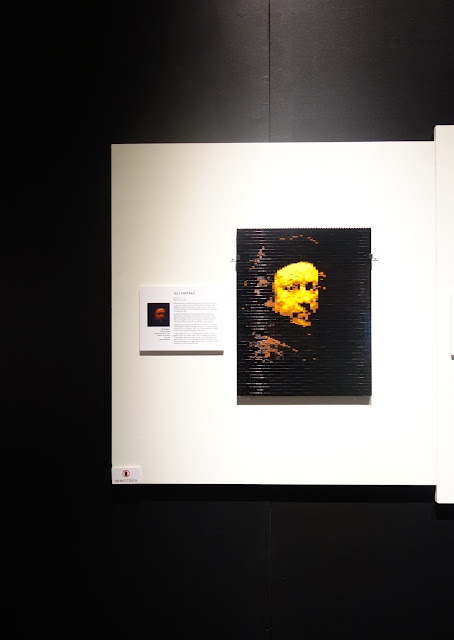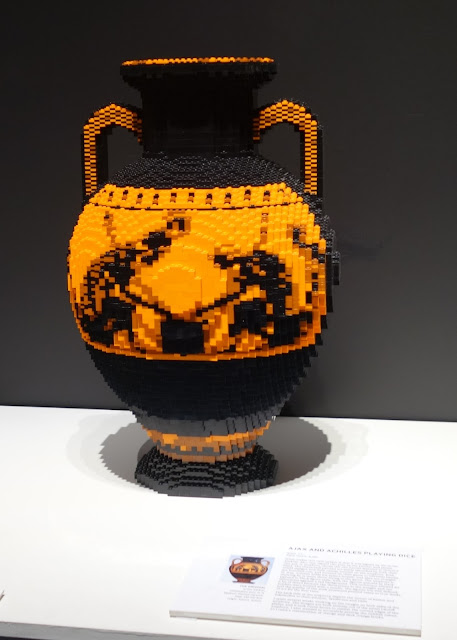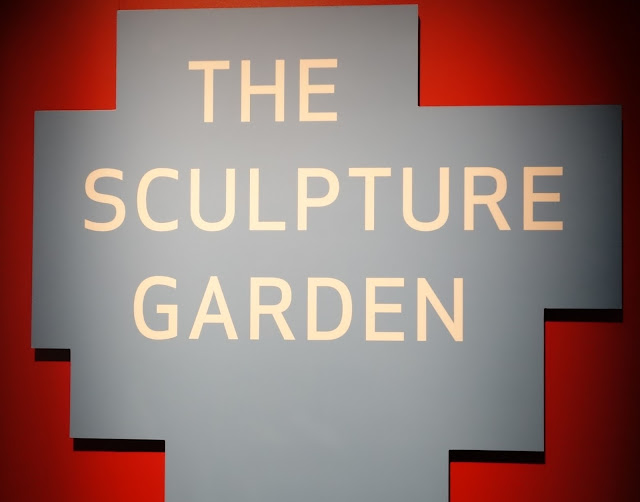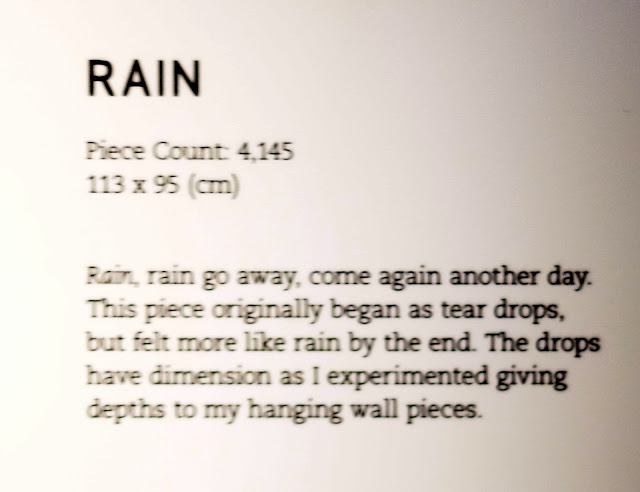On the webpage display webpage, it says: "'Named one of CNN’s Top Ten “Global Must-See Exhibitions',” The Art of the Brick exhibit by artist Nathan Sawaya is a critically acclaimed collection of inspiring artworks made exclusively from one of the most recognizable toys in the world: the LEGO® brick."
When we entered, we stood to watch a 6-minute video about the artist Nathan Sawaya.
After getting a BA in the liberal arts, he decided he needed to find a field where he could earn a living, so he went to law school. When he started practicing corporate law, whereas others exercise after work, he went home and played with his Lego, which had fascinated him since his childhood. He began making some amazing configurations, and it led him to eventually quit law and start working full time in art. At the end of the video, Sawaya said, "It all began with one piece," and here is his depiction of that.
I took pictures of most of the art. This blog will be of the photos and of his comments of how he did them. The largest used over 80,000 Lego pieces!
To begin with, Sawaya used Lego pieces to copy works of art. It really is a wonderful way to introduce children to the masters.
The first work was not one that I was familiar with. It is the Book of Dima, an Iris Gospel book. It is on a scale of 3:1 and is made up of 1,900 pieces. He decided to give this brick replica version some depth that would rise off the paper.
Next: Lotus and Swallow. I used my good Sony camera when taking pictures (without flash as instructed) and they edited in Picasa. I tried my best to keep the colors accurate but was not always successful, especially in the reds and often because of the lighting.
Often when I stood farther away, the pictures looked quote different.
Holbein, self-portrait: Holbein was a famous German painter during the first half of the 16th century.
Most of the time, the artist tried to use a scale of 1:1, keeping the work the same size of the original. As you can see, the famous work by Monet was 1:1 and used 3,708 pieces.
The Great Wave off of Kanagawa. I love this Lego 3-D rendition of the original painting!!!
The Prophet, by Emile Nolde, a German expressionist painter, using under 800 Lego pieces.
In another room, we began to see Lego sculptures of paintings. Such sculptures give a very different impression of the paintings, and use more Lego blocks. Of the first, American Gothic, I showed it in different views and close up too as one can see the work differently by looking at it at different angles. The house behind is also made of flat Lego pieces! I didn't notice it at first!
I was fascinated by the construction of the pitchfork with Legos.
An overhead sign in the exhibit has the following quote from Sawaya:
"I first learned adjectives through School House Rock.
I learned hot to count to ten through Sesame Street.
I learned about gravity through my Slinky.
Imagine if a child learns about art history through LEGO!"
Another posted quote of the artist:
"The exhibition engages the child in all of us while at the same time highlighting sophisticated and complex concepts. I use LEGO in my art because the toy is accessible. Chances are you probably don't have a slab of marble or a ceramic kiln at home. But I bet you have some LEGO bricks."
Sitting and reclining Buddhas.
As the sculptures get more complex, I was amazed by how the artist could get the recreations to balance so well and stay vertical. The work below is one that he worked hard to engineer the body to balance.
A small part of the Sistine Chapel Ceiling with over 4,000 pieces and the same size as the original.
A slide show of originals and Lego art
The hand, however, fascinates me.
I can definitely see the self-assuredness that Degas wanted to show but the feeling otherwise is very different for me than the original. But that is what Sawaya can do with his Lego art!
Venus of Wellendorf--over 27,000 years old, 830 pieces. One of the earliest known art figures of the human form found.
The Sculpture Garden room was astounding! I first was riveted by the head of a Moai statue from Easter Island, since I was at the site last November.
The Moai, with over 75,000 pieces, was the second to largest piece we saw at this exhibit. And I have seen the original! The rest of statue, by the way, is underground, covered over two plus centuries by blowing dirt.
That is I and not a statue below.
I was also captivated by the head of Nefertiti and how the artist was able to balance this artwork. I also love the colors!
Another quote by Nathan Sawaya:
"Art nurtures the brain, whether made from clay, paint, wood, or a modern-day toy."
A life-size apple and then one magnified in size:
The artist's palette:
The floor and even the file cabinet are made of LEGO!
In this section, the artist gets more creative.
The swimmer was an amazing, life-size Lego sculpture.
Facemask: With over 10,000 pieces, this is a self-portrait. He used dozens and dozens of photos of his head from all angles. It took over a month for him to make the mask. The color was actually a stronger red.
The artist says in another sign:
"My favorite subject is the human form. A lot of my work suggests a figure in
transition. It represents the metamorphosis I am experiencing in my own life. My
pieces grow out of my fears and accomplishments, as a lawyer and as an artist,
as a boy and as a man."
I loved the musical notes with heads as a base, set up to look like a wind chime.
The next two are quite powerful!
And then one room was devoted to his largest creation, a dinosaur.
I thought that might be the highlight, near the end, but I was wrong!
And then in the next room, a fascinating development: Sawaya makes a model and then it is incorporated into a painting or photo!
Can you see which object is made of Lego in the picture below?
Can you see the two items below made of Lego? I only saw one originally.
As we entered the gift shop, there were some more sculptures, which when originally done with children had their names written on blocks.
There were many good books with ideas for creating Lego in the gift shop as well as a book based on the exhibit.
And the exhibit would not be complete without a Lego play area for children.
Here is the website of the exhibit if you want to learn more about it.
If you live near Seattle, I strongly recommend that you go to see the marvelous display. I am glad that you did and wanted to share much of it with you.














































































































































